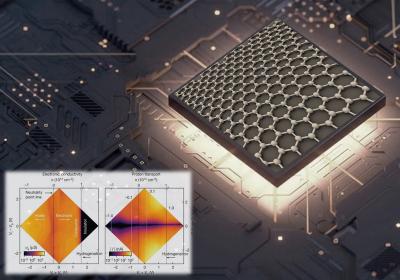Researchers from the University of Manchester, University of Cambridge, Khalifa University and Universidade Federal do Ceará have developed a new device using graphene to transform next-generation technologies in hydrogen fuel cells, computing, and catalysis.
Image credit: Khalifa University
The team's research shows that the properties of a graphene sheet can be fine-tuned with the help of electric fields to independently host proton and electron currents, thus setting the stage for a device that serves both computer memory and logic functions.
By using a technique known as double gating, where graphene is sandwiched between non-aqueous electrolytes and connected to gate electrodes on each side to induce electrons to flow through the sheet, researchers enabled independent control of proton transport and proton chemisorption (also known as hydrogenation). By precisely tuning the voltages on the electrodes, the authors were able to enhance the perpendicular flow of protons through graphene. Another combination of voltages induced hydrogenation of the crystal lattice and the associated transition to an insulating state, which compromises graphene’s superior electrical conductivity by disrupting the flow of electrons through the sheet.
Khalifa University's Dr. Lourdes Vega said: “Such control between both the proton transport and the two conductive states (insulator and conductor) are so robust and reproducible that can be exploited to build a device that performs both memory and logic functions in a computer, a milestone achievement because it combines the functionalities of two devices into one and eliminates the need for other circuits to link them. The discovery can also have implications in proton-conducting membranes for hydrogen, catalysis and isotope separation.”


